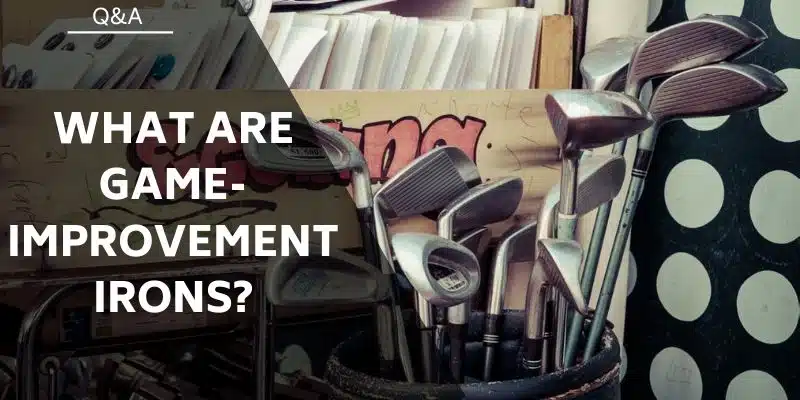Understanding the attack angle in golf is crucial for optimizing ball flight, maximizing distance, and enhancing accuracy. It significantly affects your swing efficiency and directly impacts your overall golf game.
What is an angle of attack in golf? The angle of attack refers to the angle at which the clubhead approaches the ball during impact, influencing ball flight, spin, and distance. This angle usually varies from +2 for a driver to -7 for your wedges. It also depends on your unique swing style. For example, Rory McIlroy has a +5 attack angle for his driver.
In this guide, we’ll delve deep into the angle of attack in golf, exploring its definition, the impact of various clubs, common mistakes, and helpful tips for improving your angle of attack.
By understanding and mastering this crucial aspect of your golf swing, improvements can be made in your ball striking.
What Is An Angle of Attack In Golf?
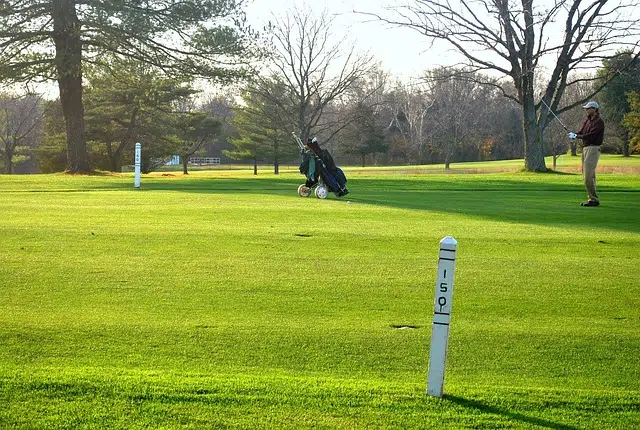
The angle of attack is the angle at which the clubhead approaches the ball at the moment of impact. It is measured relative to the ground and can be positive (upward) or negative (downward).
A positive angle of attack means that the clubhead is moving upward as it strikes the ball, while a negative angle indicates that the clubhead is moving downward.
Clubface angle refers to the orientation of the clubface at impact, determining the initial direction of the ball flight. Swing plane, on the other hand, is the path the club travels throughout the swing.
Although angle of attack, clubface angle, and swing plane all contribute to the overall success of a golf shot, they are distinct concepts that each play a unique role in shaping your swing.
Golf Attack Angle For Each Club
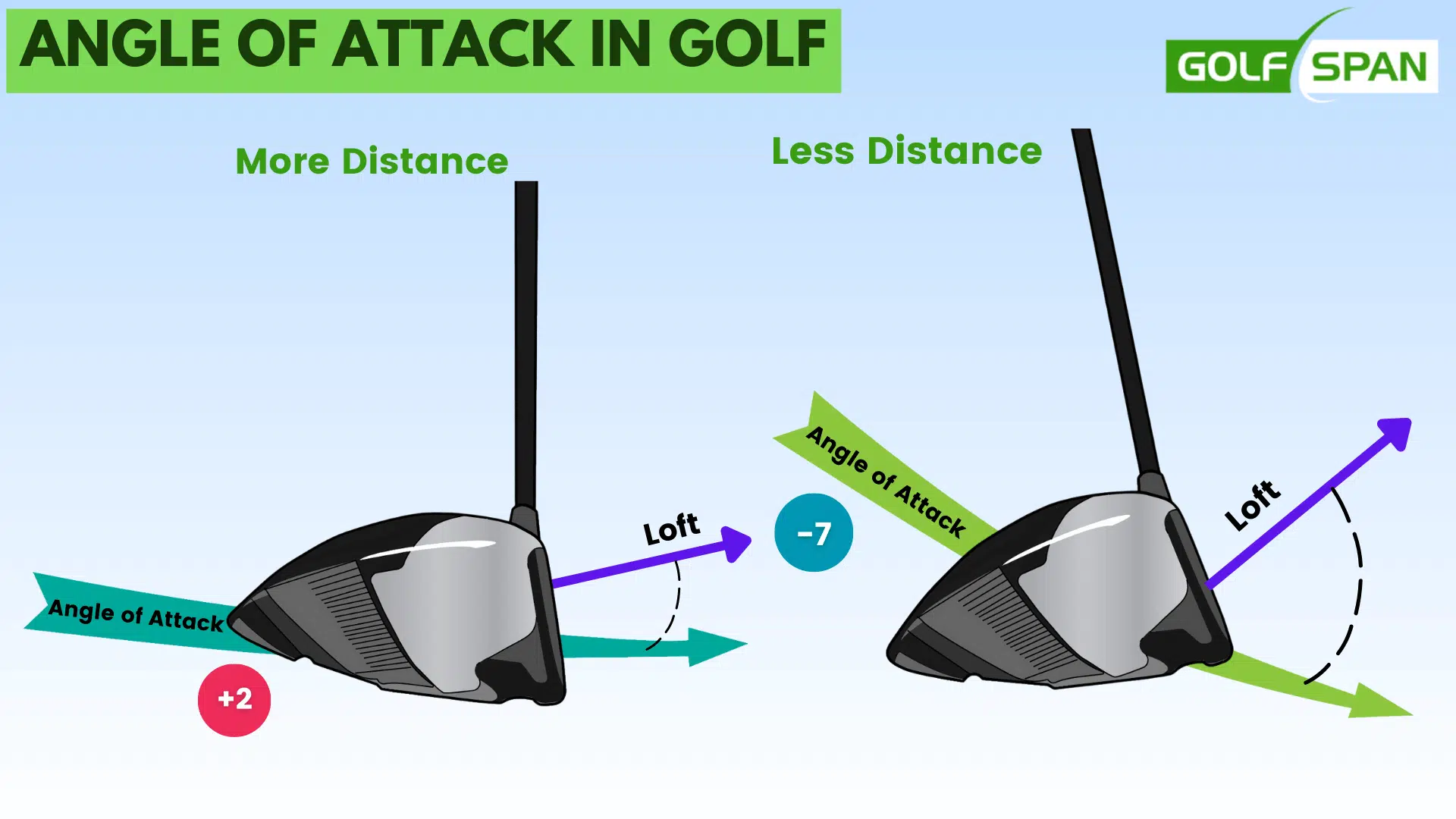
So now we know what an angle of attack is, let’s figure out what a GOOD angle of attack is for each club.
| Club | Ideal Angle of Attack (degrees) |
| Driver | +2 to +5 |
| 3-wood | -1 to +2 |
| 5-wood | -2 to 0 |
| Hybrid | -3 to -1 |
| Long Irons (2-4) | -4 to -2 |
| Mid Irons (5-7) | -5 to -3 |
| Short Irons (8-PW) | -6 to -4 |
| Wedges | -7 to -5 |
The design, loft, and length of a golf club influence the ideal angle of attack. Longer clubs, such as drivers, require a shallower angle of attack to achieve optimal trajectory and distance.
Check out our article on low golf shots for more information.
In contrast, shorter clubs like wedges demand a steeper angle of attack for better control and precision.
You can find your angle of attack with a launch monitor or with the help of a golf instructor.
What is a Steep Angle of Attack?
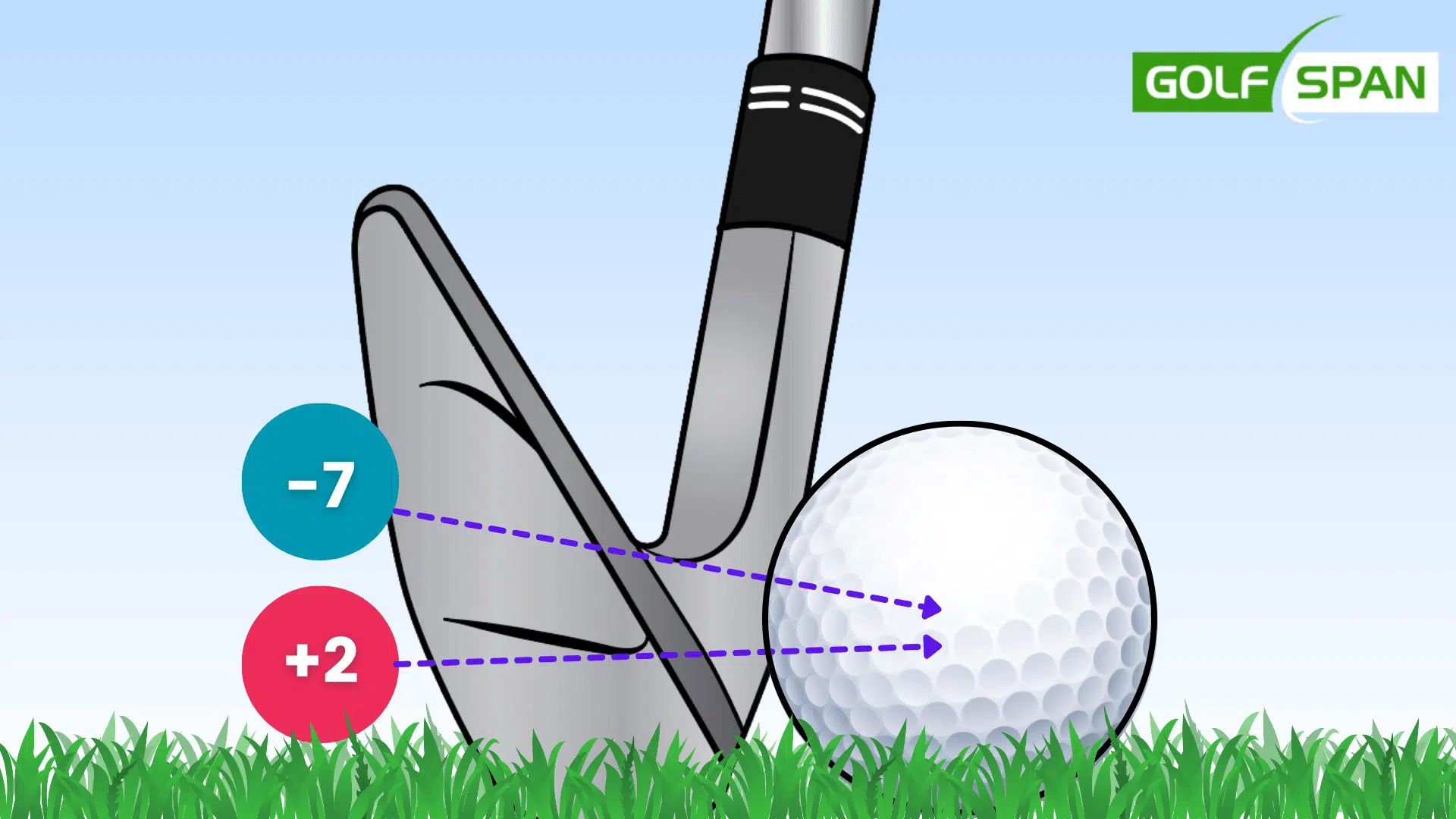
A steep angle of attack in golf refers to the path the clubhead takes as it approaches and makes contact with the golf ball. When a golfer has a steep angle of attack, the clubhead travels on a sharp downward path toward the ball, creating a more significant angle between the ground and the club’s trajectory. This angle often results in a more vertical clubhead movement during impact, leading to various swing characteristics and outcomes.
There are several reasons why a golfer might have a steep angle of attack. One common cause is an overly steep swing plane, which swings the club on a more vertical path around the body. This can result from several factors, such as incorrect grip, poor posture, or improper weight shift during the swing.
Another reason for a steep angle of attack is an aggressive downswing that originates from the upper body, leading to an early release of the club and a downward strike on the ball. This can be caused by a lack of lower body rotation, resulting in the upper body dominating the downswing and creating a chopping motion.
What is a Shallow Angle of Attack?
A shallow angle of attack in golf refers to the path the clubhead takes as it approaches and makes contact with the golf ball, with a more level or slightly upward trajectory than a steeper angle. When a golfer has a shallow angle of attack, the clubhead’s path is more horizontal, creating a smaller angle between the ground and the club’s trajectory. This angle often creates a more sweeping motion during impact, leading to various swing characteristics and outcomes.
Shallow angles of attack can be particularly beneficial when using longer clubs, such as drivers and fairway woods. By having a less negative or even positive angle of attack, golfers can create cleaner contact with the ball, resulting in decreased spin and increased distance.
Tips to Improve Attack Angle
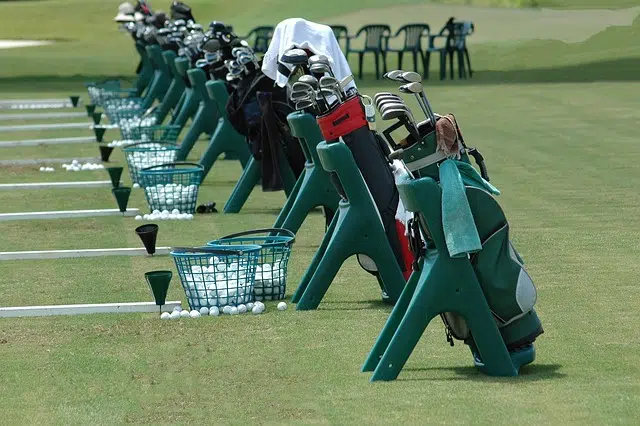
Drills And Exercises To Improve Your Angle Of Attack
- Tee height drill: For driver practice, experiment with different tee heights to encourage a more positive angle of attack. This will help you find the optimal tee height for your swing and promote better contact with the ball. A good angle of attack can help mitigate slices and hooks off the tee.
- Alignment stick drill: Place an alignment stick on the ground, angled to mimic your desired attack angle. Practice swinging along the stick to develop a feel for the correct angle. This will help you create a more consistent and efficient swing.
- Impact bag: Use an impact bag to practice striking the ball with the proper angle of attack. This will help you focus on generating the ideal angle at impact while also improving your overall contact and ball striking.
- Divot analysis: Analyze your divots during practice sessions. Divots that are too deep or shallow can indicate an improper angle of attack. Adjust your swing accordingly to achieve better contact and more consistent ball striking.
- Video analysis: Record your swing during practice and analyze the angle of attack. Use slow-motion playback to identify any issues and make adjustments as needed.
Tips For Incorporating Angle Of Attack Into Your Practice Routine
- Dedicate time during practice sessions specifically to working on your angle of attack. Focusing on this aspect of your swing can significantly improve your overall game.
- Be mindful of your attack angle when practicing with various clubs. Each club requires a different angle of attack, so be sure to adjust your swing accordingly.
- Work with a golf professional or coach who can provide personalized guidance and feedback on your angle of attack. This can help you make the necessary adjustments to improve your swing.
How To Monitor Progress And Make Adjustments
- Regularly measure your angle of attack using a launch monitor or other golf swing analysis tools. This will help you track your progress and make any necessary adjustments.
- Pay attention to the ball flight, distance, and spin during practice sessions. These factors can indicate whether your angle of attack is improving or if further adjustments are needed.
- Revisit the drills and exercises mentioned above, and continually work on refining your angle of attack for optimal performance on the course.
Common Angle of Attack Mistakes
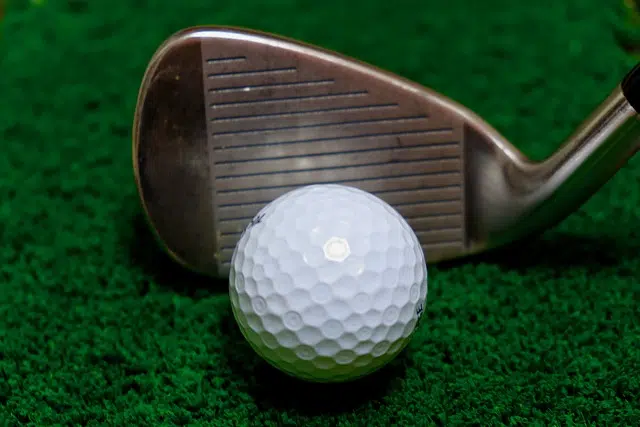
- Overly steep angle of attack: An excessively steep angle can lead to poor contact, loss of distance, and increased spin. Focus on maintaining a more neutral angle to improve ball striking and optimize distance.
- Overly shallow angle of attack: A too-shallow angle can cause thin shots and difficulty generating optimal spin on shorter clubs. Adjust your swing to strike the ball slightly steeply for better contact and control.
- Inconsistent angle of attack: If your angle of attack varies significantly from shot to shot, you’ll struggle to achieve consistent results. Develop a more consistent swing through dedicated practice and by incorporating the tips and drills mentioned earlier in this guide.
Read more: How To Hit A Driver Consistently
Frequently Asked Questions
What Is Rory McIlroy's Attack Angle?
Rory McIlroy's attack angle with his driver is typically around +5 degrees.
Is A Higher Angle Of Attack Better?
A higher angle of attack can be beneficial for maximizing distance with drivers and fairway woods, but it may not be ideal for all clubs or players. It's essential to find the optimal angle of attack for your unique swing and the club you're using.
What Is The Ideal Attack Angle For A 7 Iron?
The angle of attack for a 7 iron should be between -4 and -1 degrees.
What Is A Good Angle Of Attack For A Driver?
A positive angle of attack between +2 to +5 degrees is generally considered ideal for a driver. This allows for optimal launch conditions, maximizing both distance and accuracy.
How Do I Know If My Angle Of Attack Is Too Steep Or Shallow?
Monitor your ball flight, divots, and contact during practice sessions to determine if your angle of attack is too steep or shallow. Deep divots and a loss of distance may indicate a steep angle, while thin shots and difficulty generating spin on short clubs may suggest a shallow angle.
Using a launch monitor or working with a golf instructor can also help you identify and correct issues with your angle of attack.
Can Angle Of Attack Be Improved Through Strength Training?
While strength training can enhance your overall golf performance, combining it with targeted swing drills and exercises to improve your angle of attack specifically is crucial.
Focusing on both physical conditioning and technical aspects of your swing will lead to the most significant improvements in your angle of attack and overall game.
How Often Should I Measure My Angle Of Attack?
Measuring your angle of attack regularly can help you monitor progress and make necessary adjustments. Consider measuring it every few weeks or after a significant change in your swing technique.
Working with a golf instructor or using a launch monitor can provide valuable insights into your angle of attack and overall swing performance.
Conclusion
Understanding and mastering the angle of attack within your golf swing is essential for optimizing ball flight, distance, and accuracy. It significantly affects your swing efficiency and directly impacts your overall golf game.
To improve your angle of attack, dedicate time to practice, focus on specific drills and exercises, and work with a golf professional or coach for personalized guidance. By consistently monitoring your progress and making necessary adjustments, you’ll unlock your full potential on the golf course and elevate your performance to new heights.
Sam has been playing golf for over 20 years and founded Impact Golfer. As a teenager, he discovered his love for the game using his grandad’s clubs, including a wooden driver. As a golf obsessive, Sam plays whenever possible, regularly competing in matchplay with his friends and in tournaments at his local club. He's fortunate to have a close friend who is a club pro– he has tested almost every type of equipment on the market (no freebies yet).
Sam has a handicap index of 13 and likes playing at the Metro Golf Centre near his home in London. He putts with a Taylormade Spider because Rory uses it but regrets selling an old Scotty Cameron putter on eBay.
- Best score: 94
- Favorite club: TaylorMade Stealth Driver
- Favorite putter: Bought a TaylorMade Spider because Rory uses it, but spend most of my time on greens yearning for the Scotty Cameron I sold on eBay.
- Favorite food at the turn: Baguette. Sausages. Bacon. HP Sauce.






